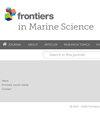Distribution and abundance of squat lobster (Pleuroncodes monodon) and its association with anchoveta in the coastal zone of the Peruvian Current (1998–2024)
IF 3
2区 生物学
Q1 MARINE & FRESHWATER BIOLOGY
引用次数: 0
Abstract
The squat lobster or munida (秘鲁海流沿海地区深蹲龙虾(Pleuroncodes monodon)的分布、丰度及其与鳀鱼的关系(1998-2024)
深蹲龙虾是秘鲁海流沿海地区最丰富的物种之一。由于其高发生率和高生物量,自1998年以来,海洋研究所Perú (IMARPE)一直通过凤尾鱼和其他远洋资源水声评估调查对其进行监测。本文对1998 ~ 2024年进行的59次调查进行了分析,探讨了凤尾鱼(Engraulis ringens)与munida的空间分布、丰度及其生态关系。结果表明,1998年至2000年间,munida沿着秘鲁海岸向北扩展了其分布,而从2001年起,其分布范围保持相对稳定。在冬季和春季,分布面积和惯性增加,物种倾向于远离海岸,而在夏季和秋季,除了异常海洋事件(如温暖或寒冷条件),分布收缩。在垂直方向上,munida通常居住在大约168米深的表层,尽管在2015 -2016年El Niño事件期间,它被记录为203米深。整个研究期间的平均生物量接近204万吨,1703- 2004年调查期间记录的最大值为538万吨。Munida也是与鳀鱼关系最密切的物种,当两者同时发生时,它们的相互作用随一天中的时间而变化,可能反映了昼夜垂直迁移和不同的聚集行为。这些发现表明,穆尼达是秘鲁海流生态系统的一个关键组成部分,其变异性受到季节周期和异常海洋学条件的影响,其与凤尾鱼的关联可能对该区域的生态系统功能和渔业管理产生影响。
本文章由计算机程序翻译,如有差异,请以英文原文为准。
求助全文
约1分钟内获得全文
求助全文
来源期刊

Frontiers in Marine Science
Agricultural and Biological Sciences-Aquatic Science
CiteScore
5.10
自引率
16.20%
发文量
2443
审稿时长
14 weeks
期刊介绍:
Frontiers in Marine Science publishes rigorously peer-reviewed research that advances our understanding of all aspects of the environment, biology, ecosystem functioning and human interactions with the oceans. Field Chief Editor Carlos M. Duarte at King Abdullah University of Science and Technology Thuwal is supported by an outstanding Editorial Board of international researchers. This multidisciplinary open-access journal is at the forefront of disseminating and communicating scientific knowledge and impactful discoveries to researchers, academics, policy makers and the public worldwide.
With the human population predicted to reach 9 billion people by 2050, it is clear that traditional land resources will not suffice to meet the demand for food or energy, required to support high-quality livelihoods. As a result, the oceans are emerging as a source of untapped assets, with new innovative industries, such as aquaculture, marine biotechnology, marine energy and deep-sea mining growing rapidly under a new era characterized by rapid growth of a blue, ocean-based economy. The sustainability of the blue economy is closely dependent on our knowledge about how to mitigate the impacts of the multiple pressures on the ocean ecosystem associated with the increased scale and diversification of industry operations in the ocean and global human pressures on the environment. Therefore, Frontiers in Marine Science particularly welcomes the communication of research outcomes addressing ocean-based solutions for the emerging challenges, including improved forecasting and observational capacities, understanding biodiversity and ecosystem problems, locally and globally, effective management strategies to maintain ocean health, and an improved capacity to sustainably derive resources from the oceans.
 求助内容:
求助内容: 应助结果提醒方式:
应助结果提醒方式:


